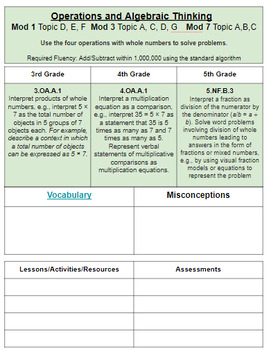4th Grade Math Standards Aligned with Achieve the Core Coherence Map
Olmos in the Classroom
0 Followers
Grade Levels
3rd - 5th
Subjects
Standards
CCSS4.MD.B.4
CCSS4.NBT.B.4
CCSS4.OA.A.1
CCSS4.NF.A.1
CCSS4.G.A.1
Formats Included
- Google Slides™
Olmos in the Classroom
0 Followers

Made for Google Drive™
This resource can be used by students on Google Drive or Google Classroom. To access this resource, you’ll need to allow TPT to add it to your Google Drive. See our FAQ and Privacy Policy for more information.
Description
The 4th Grade priority, additional, and supporting standards aligned with 3rd and 4th grade standards. This is a planning tool to help see the vertical articulation amongst the standards. On top of each page you can also see where this standard is found in Eureka Math.
Total Pages
Answer Key
N/A
Teaching Duration
N/A
Report this resource to TPT
Reported resources will be reviewed by our team. Report this resource to let us know if this resource violates TPT’s content guidelines.
Standards
to see state-specific standards (only available in the US).
CCSS4.MD.B.4
Make a line plot to display a data set of measurements in fractions of a unit (1/2, 1/4, 1/8). Solve problems involving addition and subtraction of fractions by using information presented in line plots. For example, from a line plot find and interpret the difference in length between the longest and shortest specimens in an insect collection.
CCSS4.NBT.B.4
Fluently add and subtract multi-digit whole numbers using the standard algorithm.
CCSS4.OA.A.1
Interpret a multiplication equation as a comparison, e.g., interpret 35 = 5 × 7 as a statement that 35 is 5 times as many as 7 and 7 times as many as 5. Represent verbal statements of multiplicative comparisons as multiplication equations.
CCSS4.NF.A.1
Explain why a fraction 𝘢/𝘣 is equivalent to a fraction (𝘯 × 𝘢)/(𝘯 × 𝘣) by using visual fraction models, with attention to how the number and size of the parts differ even though the two fractions themselves are the same size. Use this principle to recognize and generate equivalent fractions.
CCSS4.G.A.1
Draw points, lines, line segments, rays, angles (right, acute, obtuse), and perpendicular and parallel lines. Identify these in two-dimensional figures.


